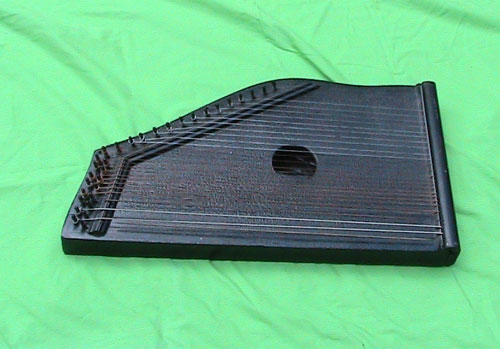
|
Surmandal otherwise known as swarmandal, is basically a small
harp. It is generally used for the drone to accompany vocalists.
Although it is considered a minor instrument, as a class the harps
are very old in India.
There is no such thing as a standard tuning for surmandal. Although this lack of standard tuning is discomforting to the average Western musician, it really is rather obvious. We must not forget that:
Stringing a surmandal for any individual is basically one of trial and error. Fortunately the latitude is so great that there is very little "error". It is usually more a question of individual taste. Simply start the low strings with strings that are that are intuitively low (e.g., brass, bronze, wire wrapped, etc). Start stringing it, and then gradually work your way up to strings which are intuitively high (e.g., light gauge, steel). Tuning is very simple, but you must first know two things. You must know what key that you sing in (i.e., safed ek (C), kali ek (C#), safed do (D), etc.). You must also know what rag that you wish to perform. We must presume that you know both of these things. Start the tuning with the lowest string and work your way up. Simply start with the lowest string and tighten it until the tension feels comfortable. At that point find the nearest note which is in the rag and tune to it. Try to tune to Sa or Pa. Then tune the next string, and the next, etc. You will quickly reach a point that the strings are getting too tight. At that point you can double up on the tuning. That is to say that you tune two or more strings to the same note. Then again you go up the scale. Again you reach a point where it is getting too tight. Again you double up the tuning. Repeat this entire process until the instrument is in tune. One can use any note to double up on, however Sa and Pa are very comfortable. Initially it is good to tune to a seven note scale (sampurna jati) (see jati for more information). Therefore, if you need to switch to a five note scale (audav) or a six note scale (shadav), then all that you have to do is double up on the appropriate strings. You do not wish to go back and retune the whole instrument when simply doubling up on the strings will do the job. The surmandal is now in tune. As you work with your surmandal you will find yourself tailoring it to your own needs. You will find that changing the gauge or material of a string here and there, or a slight alteration of the tunings are in order. However, you will find that very quickly you have your surmandal as you like it.
|
||